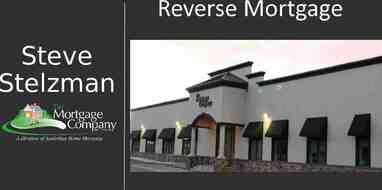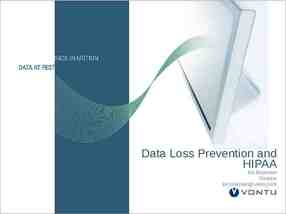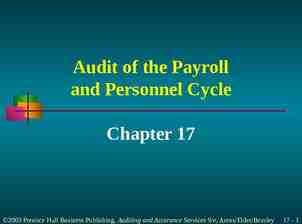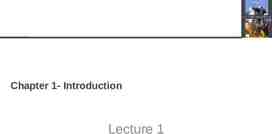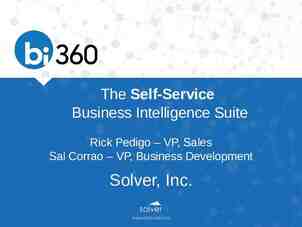Future PASSHE Academic Libraries & Collaboration sweeney@njit Richard
71 Slides2.28 MB

Future PASSHE Academic Libraries & Collaboration [email protected] Richard Sweeney 973-596-3208 Powerpoint Powerpoint (Revised (Revised 5/8/2008) 5/8/2008) available available at: at: http://library1.njit.edu/staff-folders/sweeney/ http://library1.njit.edu/staff-folders/sweeney/

Future PASSHE Academic Libraries & Collaboration [email protected] Richard Sweeney 973-596-3208 Please take a minute and draft your own one sentence definitions. Define an academic library in one sentence. Define the PASSHE library system in one sentence.

Future PASSHE Academic Libraries & Collaboration [email protected] Richard Sweeney 973-596-3208 “The library connects us with insights and knowledge, painfully extracted from nature, of the greatest minds that ever were, with the best teachers, drawn from the entire planet and from all of our history, to instruct us without tiring, and to inspire us to make our own contribution to the collective knowledge of the human species.” p. 282 Carl Sagan, Cosmos Random House, New York, 1980 p. 282

Future PASSHE Academic Libraries & Collaboration [email protected] Richard Sweeney 973-596-3208 “The library connects us with insights and knowledge, painfully extracted from nature, of the greatest minds that ever were, with the best teachers, drawn from the entire planet and from all of our history, to instruct us without tiring, and to inspire us to make our own contribution to the collective knowledge of the human species.” p. 282 This is the essence of scholarly communication and the primary role of the academic library. Carl Sagan, Cosmos Random House, New York, 1980 p. 282

Future PASSHE Academic Libraries & Collaboration [email protected] Richard Sweeney 973-596-3208 The changing patterns of research and learning in higher education As part of a university or college, the academic library is not an end in itself. It supports research, learning and scholarship and has always had to adapt as research and learning behaviors change. In the current network environment, this change is uneven and poses great challenges for libraries. p. 11 OCLC Environmental Scan: Pattern Recognition (2003) http://www.oclc.org/reports/escan/

Future PASSHE Academic Libraries & Collaboration [email protected] Richard Sweeney 973-596-3208 Percentage of Materials Budget (Books, Journals vs. Databases) 90.0% At NJIT, One Paradigm Shifted in 2002 Database c osts c ontinue to inc rease & ac c ount f or a bit less than 80 perc ent of budget. 80.0% 70.0% 60.0% Books FY 50.0% Journals 40.0% All Databases 30.0% B ook B udget has dec lined in both 20.0% real dollars & perc entage. 10.0% 0.0% FY 98 FY 99 FY 00 FY 01 FY 02 FY 03 FY 04 FY 05 FY 06 FY 07 FY 08 Once in awhile, the prevailing paradigm will change.

Future PASSHE Academic Libraries & Collaboration [email protected] Richard Sweeney 973-596-3208 Agenda 9:00 – 10:30 Where do we want to be? 10:30 – 10:45 Break 10:45 – 12:00 Where are we now? 12:00 – 12:45 Lunch 12:45 – 2:30 Small Group SWOT Analysis where we want to be. 2:45 – 4:00 Entire group share analysis and build consensus on the future planning direction.

Future PASSHE Academic Libraries & Collaboration [email protected] Richard Sweeney 973-596-3208 Scholarly Communication Digital Preservation Information Competency Institutional Repositories Digital Assets E-Learning Proliferation Learning Commons Consortia Advantages Redesigned Courses Migration from Blended – Print Hybrid Librarians Long Tail: Bigger, Common, Shared Collections Self Sufficiency Technology Convergence Active Environments Bigger Catalogs: Accelerators Seamlessness Satisfaction Open Access Curating Content Personal Information Management Information Economics Intellectual Property Redeveloped & Repurposed Library Space Learner Centered Multi-Media Licensing Learning Objects

Future PASSHE Academic Libraries & Collaboration [email protected] Richard Sweeney 973-596-3208 Scholarly Communication Digital Preservation Information Competency Institutional Repositories Digital Assets E-Learning Proliferation Learning Commons Consortia Advantages Redesigned Courses Migration from Blended – Print Hybrid Librarians Long Tail: Bigger, Common, Shared Collections Self Sufficiency Technology Convergence Active Environments Bigger Catalogs: Accelerators Seamlessness Satisfaction Open Access Curating Content Personal Information Management Information Economics Intellectual Property Redeveloped & Repurposed Library Space Learner Centered Multi-Media Licensing Learning Objects

Future PASSHE Academic Libraries & Collaboration [email protected] Richard Sweeney 973-596-3208 Kohl, David F. and Tom Sanville. “More Bang for the Buck; Increasing Effectiveness of Library Expenditures Through Cooperation” Library Trends, Vol. 54 no. 3 pp394-410

Future PASSHE Academic Libraries & Collaboration [email protected] Richard Sweeney 973-596-3208

Future PASSHE Academic Libraries & Collaboration [email protected] Richard Sweeney 973-596-3208 Scholarly Communication Digital Preservation Information Competency Institutional Repositories Digital Assets E-Learning Proliferation Learning Commons Consortia Advantages Redesigned Courses Migration from Blended – Print Hybrid Librarians Long Tail: Bigger, Common, Shared Collections Self Sufficiency Technology Convergence Active Environments Bigger Catalogs: Accelerators Seamlessness Satisfaction Open Access Curating Content Personal Information Management Information Economics Intellectual Property Redeveloped & Repurposed Library Space Learner Centered Multi-Media Licensing Learning Objects

Future PASSHE Academic Libraries & Collaboration [email protected] Richard Sweeney 973-596-3208 “Long Tail; The economics of abundance. “Use “Book Titles Anderson, Chris. The Long Tail: Why the Future of Business Is Selling Less of More (2006) Hyperion. New York

Future PASSHE Academic Libraries & Collaboration [email protected] Richard Sweeney 973-596-3208 “We are entering an era of unprecedented choice and that’s a good thing. “ p. 169 Anderson, Chris. The Long Tail: Why the Future of Business Is Selling Less of More (2006) Hyperion. New York

Future PASSHE Academic Libraries & Collaboration [email protected] Richard Sweeney 973-596-3208 “.there are far more niche goods than hits “the cost of reaching those niches is now falling dramatically. “These “filters” [recommendations] can drive demand down the Tail. “There are still hits and niches, but the hits are relatively less popular and the niches relatively more so. . “ p. 53 Anderson, Chris. The Long Tail: Why the Future of Business Is Selling Less of More (2006) Hyperion. New York

Future PASSHE Academic Libraries & Collaboration Library Materials Budget [email protected] Richard Sweeney 1,131,777 973-596-3208 259,772 76,698 547,900 290,088 866,590 2,013,101 780,062 “Use 584,643 331,420 “Book Titles 983,441 842,211 Anderson, Chris. The Long Tail: Why the Future of Business Is Selling Less of More (2006) Hyperion. 727,241 New York 1,770,925 11,205,869

Future PASSHE Academic Libraries & Collaboration [email protected] Richard Sweeney 973-596-3208 Scholarly Communication Digital Preservation Information Competency Institutional Repositories Digital Assets E-Learning Proliferation Learning Commons Consortia Advantages Redesigned Courses Migration from Blended – Print Hybrid Librarians Long Tail: Bigger, Common, Shared Collections Self Sufficiency Technology Convergence Active Environments Bigger Catalogs: Accelerators Seamlessness Satisfaction Open Access Curating Content Personal Information Management Information Economics Intellectual Property Redeveloped & Repurposed Library Space Learner Centered Multi-Media Licensing Learning Objects

Future PASSHE Academic Libraries & Collaboration [email protected] Richard Sweeney 973-596-3208 “The underlying focus for budgetary attention, whether times are flush or flushed, should be a concern to get the most value out of each dollar spent.” P. 394 Kohl, David F. and Tom Sanville. “More Bang for the Buck; Increasing Effectiveness of Library Expenditures Through Cooperation” Library Trends, Vol. 54 no. 3 pp394-410

Future PASSHE Academic Libraries & Collaboration [email protected] Richard Sweeney 973-596-3208 “Possibly the most well-known intersection of automation and consortia has been the “Big Deal”, or variations on group electronic journal licensing, with the resultant tremendous increase in journal literature access for patrons and the leveraging of the collection’s dollar this model of of journal purchase has made possible.” p. 400 Kohl, David F. and Tom Sanville. “More Bang for the Buck; Increasing Effectiveness of Library Expenditures Through Cooperation” Library Trends, Vol. 54 no. 3 pp394-410

Future PASSHE Academic Libraries & Collaboration [email protected] Richard Sweeney 973-596-3208 “The most common misunderstanding involving the “Big Deal” and its variants is that it is a mechanism to save money and reduce library expenditures.” P. 401 Kohl, David F. and Tom Sanville. “More Bang for the Buck; Increasing Effectiveness of Library Expenditures Through Cooperation” Library Trends, Vol. 54 no. 3 pp394-410

Future PASSHE Academic Libraries & Collaboration [email protected] Richard Sweeney 973-596-3208 “Being able to spread the operating and development costs among multiple libraries minimizes duplication of effort, builds a facility that all members can use, and creates a collective body of content.” P. 406 Kohl, David F. and Tom Sanville. “More Bang for the Buck; Increasing Effectiveness of Library Expenditures Through Cooperation” Library Trends, Vol. 54 no. 3 pp394-410

Future PASSHE Academic Libraries & Collaboration [email protected] Richard Sweeney 973-596-3208 Scholarly Communication Digital Preservation Information Competency Institutional Repositories Digital Assets E-Learning Proliferation Learning Commons Consortia Advantages Redesigned Courses Migration from Blended – Print Hybrid Librarians Long Tail: Bigger, Common, Shared Collections Self Sufficiency Technology Convergence Active Environments Bigger Catalogs: Accelerators Seamlessness Satisfaction Open Access Curating Content Personal Information Management Information Economics Intellectual Property Redeveloped & Repurposed Library Space Learner Centered Multi-Media Licensing Learning Objects

Future PASSHE Academic Libraries & Collaboration [email protected] Richard Sweeney e of Arabia The Great Escape Best War Movies 973-596-3208 Apocalypse Now nal Catch Me If You CanDir: Dir: Steven Frank Darabont Spielberg Minority Report m Hanks Actor: Tom Hanks Actor: Tom Hanks Schindler’s List Artificial Intelligen Actor: Tom Hanks Actor: Tom Hanks You’ve Got Mail Away The The Green Mile Saving Private Toy Story 2 favorite online Millennial environment, is virtual, (1998) ) (1999) Ryan (1998) (1999) interactive, multimedia, this is one Dir: Nora Ephron obert Zemeckis Dir: Frank Darabont Dir: Steven full motion, Dir: Rich, Leepersonalized, Unkrich of my Starring: and sociallyStarring: networked. ng: Starring:customized, Spielberg favorites. Janet Tom Hanks, Hanks, Tom Hanks, Starring: Tom Hanks Meg Ryan, n Hunt, Michael Clarke Duncan, Tom Hanks, Tim Allen Media Consumers Parker Posey, e Wildman,David Morse, Tom Sizemore, Don Rickles

Future PASSHE Academic Libraries & Collaboration [email protected] Richard Sweeney 973-596-3208 Scholarly Communication Digital Preservation Information Competency Institutional Repositories Digital Assets E-Learning Proliferation Learning Commons Consortia Advantages Redesigned Courses Migration from Blended – Print Hybrid Librarians Long Tail: Bigger, Common, Shared Collections Self Sufficiency Technology Convergence Active Environments Bigger Catalogs: Accelerators Seamlessness Satisfaction Open Access Curating Content Personal Information Management Information Economics Intellectual Property Redeveloped & Repurposed Library Space Learner Centered Multi-Media Licensing Learning Objects

Future PASSHE Academic Libraries & Collaboration [email protected] Richard Sweeney 973-596-3208 Teaching-Centered Learning-Centered Deliver instruction Produce learning Transfer of knowledge from Discovery and construction of teacher to student knowledge Active faculty Active students One teaching style Multiple learning styles Curriculum development Learning technologies development Quantity and quality of resources Quantity and quality of outcomes Robert B. Barr and John Tagg, "From Teaching to Learning: A New Paradigm for Undergraduate Education," Change, vol. 27, no. 6 (November/December 1995): 12–25.

Future PASSHE Academic Libraries & Collaboration [email protected] Richard Sweeney 973-596-3208 Teaching-Centered Learning-Centered Quality of faculty Quality of students Time held constant; learning varies Learning held constant; time varies Learning is linear and cumulative Learning is a nesting and interacting of frameworks Promote recall Promote understanding Faculty are lecturers Faculty are designers of learning environments Learning is competitive and individualistic Learning is cooperative and collaborative Robert B. Barr and John Tagg, "From Teaching to Learning: A New Paradigm for Undergraduate Education," Change, vol. 27, no. 6 (November/December 1995): 12–25.

Future PASSHE Academic Libraries & Collaboration [email protected] Richard Sweeney 973-596-3208 Learning Strategies for Millennials: 1. Increase teacher – student interaction; feedback 2. Engage students (motivation; involvement) 3. Accelerate student learning 4. Increase experiential learning (gaming; simulations, role playing) 5. Increase learning options 6. Increase peer-to-peer (collaboration) learning 7. Offer more “pull” web based learning options 8. Offer more interactive multimedia learning. Millennial Learning Strategies

Future PASSHE Academic Libraries & Collaboration [email protected] Richard Sweeney 973-596-3208 Scholarly Communication Digital Preservation Information Competency Institutional Repositories Digital Assets E-Learning Proliferation Learning Commons Consortia Advantages Redesigned Courses Migration from Blended – Print Hybrid Librarians Long Tail: Bigger, Common, Shared Collections Self Sufficiency Technology Convergence Active Environments Bigger Catalogs: Accelerators Seamlessness Satisfaction Open Access Curating Content Personal Information Management Information Economics Intellectual Property Redeveloped & Repurposed Library Space Learner Centered Multi-Media Licensing Learning Objects

Future PASSHE Academic Libraries & Collaboration [email protected] Richard Sweeney 973-596-3208 “Two proven innovation strategies are the common-course redesign strategy and the flex program and service redesign strategy. These strategies use IT innovatively to improve accountability-that is, to improve and account for institutional performance-whenever measurably improved academic results and reduced unit costs are simultaneous goals.” p. 79 Graves, XXXXXXXXXXXXXXXXXXXXXXXXXXX William. Institutional Performance through ITForeman, Joel. “Improving “Next-Generation Educational Technology Enabled Innovation”. Versus the Lecture.”EDUCAUSE Review Nov/Dec 2005: 79-98 Engagement & Productivity

Future PASSHE Academic Libraries & Collaboration [email protected] Richard Sweeney 973-596-3208 “With a few important [ IT ] exceptions, these investments did not directly seek to reduce longterm unit costs and/or dampen spiraling tuition increases and, not surprisingly, did not do so whether or not they used technology to enable innovation. As a result, these “innovations” did not increase productivity but instead either added to long-term operating expenditures or proved unsustainable after the loss of special funding. p. 84 Graves, XXXXXXXXXXXXXXXXXXXXXXXXXXX William. Institutional Performance through ITForeman, Joel. “Improving “Next-Generation Educational Technology Enabled Innovation”. Versus the Lecture.”EDUCAUSE Review Nov/Dec 2005: 79-98 Engagement & Productivity

Future PASSHE Academic Libraries & Collaboration [email protected] Richard Sweeney 973-596-3208 “To one degree or another, all thirty projects share the following six characteristics: 1. Whole course redesign 2. Active learning (learner centered) 3. Computer-based learning resources 4. Master learning (scheduled milestones for completion) 5. On-demand help 6. Alternative staffing (sometimes grad and undergrads)” p. 30 Twigg, XXXXXXXXXXXXXXXXXXXXXXXXXXX Carol A. “Improving Learning Educational and ReducingTechnology Costs: New Models Foreman, Joel. “Next-Generation for Online Learning”. Versus the Lecture.”EDUCAUSE Review Sep/Oct 2003: 28-38 Engagement, Assessment & Productivity

Future PASSHE Academic Libraries & Collaboration [email protected] Richard Sweeney 973-596-3208 “At UMass, attendance in the traditional format averaged 67 percent; in the redesigned course, attendance averaged 90 percent, which correlated significantly to performance on exams. In addition exams no longer emphasize recall of factual material or definitions of terms; 67 percent of the questions now require reasoning or problem-solving skills, compared with 21 percent previously” p. 32 Twigg, XXXXXXXXXXXXXXXXXXXXXXXXXXX Carol A. “Improving Learning Educational and ReducingTechnology Costs: New Models Foreman, Joel. “Next-Generation for Online Learning”. Versus the Lecture.”EDUCAUSE Review Sep/Oct 2003: 28-38 Engagement, Assessment & Productivity

Future PASSHE Academic Libraries & Collaboration [email protected] Richard Sweeney 973-596-3208 “Preliminary results show that all thirty institutions reduced costs by about 40 percent on average, with a range of 20 to 84 percent.” p. 86 Twigg, XXXXXXXXXXXXXXXXXXXXXXXXXXX Carol A. “Improving Learning Educational and ReducingTechnology Costs: New Models Foreman, Joel. “Next-Generation for Online Learning”. Versus the Lecture.”EDUCAUSE Review Sep/Oct 2003: 28-38 Engagement, Assessment & Productivity

Future PASSHE Academic Libraries & Collaboration [email protected] Richard Sweeney 973-596-3208 “Currently in higher education, both on campus and online, we individualize faculty practice (that is, we allow individual faculty members great latitude in course development and delivery) and standardize the student learning experience (that, is we treat all students in a course as if their learning needs, interests, and abilities were the same). Instead we need to do just the opposite: individualize student learning and standardize faculty practice. ” p. 38 Twigg, XXXXXXXXXXXXXXXXXXXXXXXXXXX Carol A. “Improving Learning Educational and ReducingTechnology Costs: New Models Foreman, Joel. “Next-Generation for Online Learning”. Versus the Lecture.”EDUCAUSE Review Sep/Oct 2003: 28-38 Engagement, Assessment & Productivity

Future PASSHE Academic Libraries & Collaboration [email protected] Richard Sweeney 973-596-3208 Scholarly Communication Digital Preservation Information Competency Institutional Repositories Digital Asset Management E-Learning Proliferation Learning Commons Consortia Advantages Redesigned Courses Migration from Blended – Print Hybrid Librarians Long Tail: Bigger, Common, Shared Collections Self Sufficiency Technology Convergence Interactive Environments Library Catalogs: Accelerators Seamlessness Satisfaction Multi-Media Curating Content Personal Information Management Information Economics Intellectual Property Redeveloped & Repurposed Library Space Learner Centered Remote Assistance Licensing & Open Access Learning Objects

Future PASSHE Academic Libraries & Collaboration [email protected] Richard Sweeney 973-596-3208 Blended Librarian “An academic librarian who combines the traditional skill set of librarianship with the information technologist's hardware/software skills, and the instructional or educational designer's ability to apply technology appropriately in the teaching-learning process.” Bell, Stephen J. and John Shank. “The blended librarian: A blueprint for redefining the teaching and learning role of academic librarians ”. C&RL News, 65.7 July/August 2004 Replace Library Catalog

Future PASSHE Academic Libraries & Collaboration [email protected] Richard Sweeney 973-596-3208 Scholarly Communication Digital Preservation Information Competency Institutional Repositories Digital Assets E-Learning Proliferation Learning Commons Consortia Advantages Redesigned Courses Migration from Blended – Print Hybrid Librarians Long Tail: Bigger, Common, Shared Collections Self Sufficiency Technology Convergence Active Environments Bigger Catalogs: Accelerators Seamlessness Satisfaction Open Access Curating Content Personal Information Management Information Economics Intellectual Property Redeveloped & Repurposed Library Space Learner Centered Multi-Media Licensing Learning Objects

Future PASSHE Academic Libraries & Collaboration [email protected] Richard Sweeney 973-596-3208 Examples: Managing the Digital Enterprise (Rappa-North Carolina State) Solar System Collaboratory (Colorado) Virtual chemistry experiments (Davidson) U.S. History Videos (History Channel) BoilerCast (Purdue - podcasts, vcasts) Game Based Learning Sites (Marc Prensky) Math Emporium (Virginia Tech) Building bridges (Civil Engineering-Nova) Physics Tutorial Modules Andersen Center (RPI) Collaborative Learning Table (RPI) Immediate stock market quotes (Yahoo Finance) SearchPath information literacy tutorial (Rutgers) Examples

Future PASSHE Academic Libraries & Collaboration [email protected] Richard Sweeney Examples 973-596-3208

Future PASSHE Academic Libraries & Collaboration [email protected] Richard Sweeney 973-596-3208 Scholarly Communication Digital Preservation Information Competency Institutional Repositories Digital Assets E-Learning Proliferation Learning Commons Consortia Advantages Redesigned Courses Migration from Blended – Print Hybrid Librarians Long Tail: Bigger, Common, Shared Collections Self Sufficiency Technology Convergence Active Environments Bigger Catalogs: Accelerators Seamlessness Satisfaction Open Access Curating Content Personal Information Management Information Economics Intellectual Property Redeveloped & Repurposed Library Space Learner Centered Multi-Media Licensing Learning Objects

Future PASSHE Academic Libraries & Collaboration [email protected] Richard Sweeney 973-596-3208 “Based on these results, the best “payoffs” in higher graduation rates from strategically targeted institutional budgetary enhancements would seem to come from increasing per student expenditures for instruction ( 1.99 percentage points), followed closely by library ( 1.77) and more distantly by physical plant (1.07) and nonlibrary academic ( 0.98). Hamrick, Florence, John H Schuh and Mack C. Shelley. “Predicting Higher Education Graduation Rates from Institutional Characteristics and Resource Allocation” Education Policy Analysis Archives 12:19 (2003) http://epaa.asu.edu/epaa/v12n19

Future PASSHE Academic Libraries & Collaboration [email protected] Richard Sweeney 973-596-3208 “This study demonstrates that library expenditures and professional staff have a significant positive effect on student retention.” p. 565 Mezick, Elizabeth M. “Return on Investment: Libraries and Student Retention”. The Journal of Academic Librarianship 33:5 (2007) pp561566

Future PASSHE Academic Libraries & Collaboration [email protected] Richard Sweeney 973-596-3208 Scholarly Communication Digital Preservation Information Competency Institutional Repositories Digital Asset Management E-Learning Proliferation Learning Commons Consortia Advantages Redesigned Courses Migration from Blended – Print Hybrid Librarians Long Tail: Bigger, Common, Shared Collections Self Sufficiency Technology Convergence Interactive Environments Library Catalogs: Accelerators Seamlessness Satisfaction Multi-Media Curating Content Personal Information Management Information Economics Intellectual Property Redeveloped & Repurposed Library Space Learner Centered Remote Assistance Licensing & Open Access Learning Objects

Future PASSHE Academic Libraries & Collaboration [email protected] Richard Sweeney 973-596-3208 “Self-service: moving to self-sufficiency Banking, shopping, entertainment, research, travel, job seeking, chatting—pick a category and one theme will ring clear—self-service. People of all age groups are spending more time online doing things for themselves.” “Users DO know what they’re doing!” —Industry Pundit.” p. 4 OCLC Environmental Scan: Pattern Recognition (2003) http://www.oclc.org/reports/escan/ Self Sufficiency

Future PASSHE Academic Libraries & Collaboration [email protected] Richard Sweeney 973-596-3208 “ Bankers don’t market “distance banking” or label customers as ‘traditional’ of ‘nontraditional’. They realize that different customers have different needs and preferences for obtaining services. Banks also know that time-shifted online self-service can reduce costs while increasing customer satisfaction, which is why they frequently offer incentives for self-service.” p. 86 Graves, XXXXXXXXXXXXXXXXXXXXXXXXXXX William. Institutional Performance through ITForeman, Joel. “Improving “Next-Generation Educational Technology Enabled Innovation”. Versus the Lecture.”EDUCAUSE Review Nov/Dec 2005: 79-98 Self Sufficiency

Future PASSHE Academic Libraries & Collaboration [email protected] Richard Sweeney 973-596-3208 Scholarly Communication Digital Preservation Information Competency Institutional Repositories Digital Asset Management E-Learning Proliferation Learning Commons Consortia Advantages Redesigned Courses Migration from Blended – Print Hybrid Librarians Long Tail: Bigger, Common, Shared Collections Self Sufficiency Technology Convergence Interactive Environments Library Catalogs: Accelerators Seamlessness Satisfaction Multi-Media Curating Content Personal Information Management Information Economics Intellectual Property Redeveloped & Repurposed Library Space Learner Centered Remote Assistance Licensing & Open Access Learning Objects

Future PASSHE Academic Libraries & Collaboration [email protected] Richard Sweeney 973-596-3208 “Satisfaction Surveys confirm that information consumers are pleased with the results of their online activities Librarians worry that information found using search engines does not have the credibility and authority of information found in libraries, and that people will not learn basic information seeking skills, and so leave much valuable material undiscovered.” P. 4 OCLC Environmental Scan: Pattern Recognition (2003) http://www.oclc.org/reports/escan/ Satisfaction

Future PASSHE Academic Libraries & Collaboration [email protected] Richard Sweeney 973-596-3208 “Satisfaction Yet most library visitors also bypass the reference desk, boldly setting off to find answers on their own. The indisputable fact is that information and content on the open Web is far easier and more convenient to find and access than are information and content in physical or virtual libraries. The information consumer types a term into a search box, clicks a button and sees results immediately. The information consumer is satisfied.” p. 4 OCLC Environmental Scan: Pattern Recognition (2003) http://www.oclc.org/reports/escan/ Satisfaction

Future PASSHE Academic Libraries & Collaboration [email protected] Richard Sweeney 973-596-3208 Scholarly Communication Digital Preservation Information Competency Institutional Repositories Digital Asset Management E-Learning Proliferation Learning Commons Consortia Advantages Redesigned Courses Migration from Blended – Print Hybrid Librarians Long Tail: Bigger, Common, Shared Collections Self Sufficiency Technology Convergence Interactive Environments Library Catalogs: Accelerators Seamlessness Satisfaction Multi-Media Curating Content Personal Information Management Information Economics Intellectual Property Redeveloped & Repurposed Library Space Learner Centered Remote Assistance Licensing & Open Access Learning Objects

Future PASSHE Academic Libraries & Collaboration [email protected] Richard Sweeney 973-596-3208 “Seamlessness The traditional separation of academic, leisure and work time is fusing into a seamless world aided by nomadic computing devices that support multiple activities. This phenomenon is most marked among young adults. Their world is a seamless “infosphere” where the boundaries of work, play and study are gone, a marked contrast to the compartmentalized lifestyles of their parents. OCLC Environmental Scan: Pattern Recognition (2003) http://www.oclc.org/reports/escan/ Seamlessness

Future PASSHE Academic Libraries & Collaboration [email protected] Richard Sweeney 973-596-3208 “Seamlessness Contrast this seamless world with the one students experience at most libraries. Library environments still cater to an older generation with separate spheres of information, frequently designating different computers for access to library content than the ones used for email and writing papers. p. 4 OCLC Environmental Scan: Pattern Recognition (2003) http://www.oclc.org/reports/escan/ Seamlessness

Future PASSHE Academic Libraries & Collaboration [email protected] Richard Sweeney 973-596-3208 “Research and Learning Landscape Major trends Reduced funding Proliferation of e-learning Lifelong learning in the community The changing pattern of research and learning in higher education Institutional repositories, scholarly communication and open access New flows of scholarly materials” p. 14 OCLC Environmental Scan: Pattern Recognition (2003) http://www.oclc.org/reports/escan/ Proliferation of E-learning

Future PASSHE Academic Libraries & Collaboration [email protected] Richard Sweeney 973-596-3208 Proliferation of e-learning E-learning has a presence in most large corporations and in an ever increasing number of college and university courses. Course management systems such as WebCT and Blackboard allow for the creation of a virtual classroom where faculty and students can interact and post curriculum related material. p. 14 OCLC Environmental Scan: Pattern Recognition (2003) http://www.oclc.org/reports/escan/ Proliferation of E-learning

Future PASSHE Academic Libraries & Collaboration [email protected] Richard Sweeney 973-596-3208 Scholarly Communication Digital Preservation Information Competency Institutional Repositories Digital Asset Management E-Learning Proliferation Learning Commons Consortia Advantages Redesigned Courses Migration from Blended – Print Hybrid Librarians Long Tail: Bigger, Common, Shared Collections Self Sufficiency Technology Convergence Interactive Environments Library Catalogs: Accelerators Seamlessness Satisfaction Multi-Media Curating Content Personal Information Management Information Economics Intellectual Property Redeveloped & Repurposed Library Space Learner Centered Remote Assistance Licensing & Open Access Learning Objects

Future PASSHE Academic Libraries & Collaboration [email protected] Richard Sweeney 973-596-3208 Proliferation of e-learning “Companies purchase e-learning for workers for many of the same reasons that individuals take university courses online: travel time is reduced, infrastructure costs are low, delivery is platform-independent and learning anywhere and anytime is enabled. And elearning is big business. E-learning companies are earning millions of dollars annually.” p. 14 OCLC Environmental Scan: Pattern Recognition (2003) http://www.oclc.org/reports/escan/ Proliferation of E-learning

Future PASSHE Academic Libraries & Collaboration [email protected] Richard Sweeney 973-596-3208 Scholarly Communication Digital Preservation Information Competency Institutional Repositories Digital Asset Management E-Learning Proliferation Learning Commons Consortia Advantages Redesigned Courses Migration from Blended – Print Hybrid Librarians Long Tail: Bigger, Common, Shared Collections Self Sufficiency Technology Convergence Interactive Environments Library Catalogs: Accelerators Seamlessness Satisfaction Multi-Media Curating Content Personal Information Management Information Economics Intellectual Property Redeveloped & Repurposed Library Space Learner Centered Remote Assistance Licensing & Open Access Learning Objects

Future PASSHE Academic Libraries & Collaboration [email protected] Richard Sweeney 973-596-3208 “New standards There are two main areas of standards development. Repository and content standards are emerging to manage digital objects. Of note are OAIS (Open Archival Information System), preservation metadata, content packaging, content exchange and metadata that support operations on objects. Secondly, applications standards are being developed in the areas of cross-searching, harvesting, resolution and specialized library transaction applications such as NCIP and ISO ILL. p. 11 OCLC Environmental Scan: Pattern Recognition (2003) http://www.oclc.org/reports/escan/

Future PASSHE Academic Libraries & Collaboration [email protected] Richard Sweeney 973-596-3208 Scholarly Communication Digital Preservation Information Competency Institutional Repositories Digital Asset Management E-Learning Proliferation Learning Commons Consortia Advantages Redesigned Courses Migration from Blended – Print Hybrid Librarians Long Tail: Bigger, Common, Shared Collections Self Sufficiency Technology Convergence Interactive Environments Library Catalogs: Accelerators Seamlessness Satisfaction Multi-Media Curating Content Personal Information Management Information Economics Intellectual Property Redeveloped & Repurposed Library Space Learner Centered Remote Assistance Licensing & Open Access Learning Objects

Future PASSHE Academic Libraries & Collaboration [email protected] Richard Sweeney 973-596-3208 The changing patterns of research and learning in higher education The underlying challenges and opportunities involve the social and institutional changes necessary to effect the transition from traditional support for scholarship to the digital, distributed, seamless environments that will be necessary in the future. Consequently, coordinated management and disclosure of digital assets of institutions—learning objects, data sets, e-prints, theses, dissertations and so on—will be necessary. p. 11 OCLC Environmental Scan: Pattern Recognition (2003) http://www.oclc.org/reports/escan/

Future PASSHE Academic Libraries & Collaboration [email protected] Richard Sweeney 973-596-3208 Scholarly Communication Digital Preservation Information Competency Institutional Repositories Digital Asset Management E-Learning Proliferation Learning Commons Consortia Advantages Redesigned Courses Migration from Blended – Print Hybrid Librarians Long Tail: Bigger, Common, Shared Collections Self Sufficiency Technology Convergence Interactive Environments Library Catalogs: Accelerators Seamlessness Satisfaction Multi-Media Curating Content Personal Information Management Information Economics Intellectual Property Redeveloped & Repurposed Library Space Learner Centered Remote Assistance Licensing & Open Access Learning Objects

Future PASSHE Academic Libraries & Collaboration [email protected] Richard Sweeney 973-596-3208 The changing patterns of research and learning in higher education Currently, there are no settled patterns or standards. As well, the outputs of digital scholarship are often in complex and nonstandard forms. The academic community will need to develop a better understanding of ways in which scholarship and learning activities are created, used, reused and preserved in the digital environment. p. 11 OCLC Environmental Scan: Pattern Recognition (2003) http://www.oclc.org/reports/escan/

Future PASSHE Academic Libraries & Collaboration [email protected] Richard Sweeney 973-596-3208 The changing patterns of research and learning in higher education It is clear that a new ecology and a new economy for scholarly materials are being formed. In the past, the flow of research and learning outputs traveled through formal, linear publishing mechanisms. We are seeing the emergence of a variety of repository frameworks, metadata aggregation services, and richer content interconnection and repurposing that are changing how we think about data and its uses. p. 11 OCLC Environmental Scan: Pattern Recognition (2003) http://www.oclc.org/reports/escan/

Future PASSHE Academic Libraries & Collaboration [email protected] Richard Sweeney 973-596-3208 The changing patterns of research and learning in higher education “The library has the opportunity to take a leadership role in developing policies and programs that contribute to a coherent, institution-wide knowledge management system.” p. 11 OCLC Environmental Scan: Pattern Recognition (2003) http://www.oclc.org/reports/escan/

Future PASSHE Academic Libraries & Collaboration [email protected] Richard Sweeney 973-596-3208 Scholarly Communication Digital Preservation Information Competency Institutional Repositories Digital Asset Management E-Learning Proliferation Learning Commons Consortia Advantages Redesigned Courses Migration from Blended – Print Hybrid Librarians Long Tail: Bigger, Common, Shared Collections Self Sufficiency Technology Convergence Interactive Environments Library Catalogs: Accelerators Seamlessness Satisfaction Multi-Media Curating Content Personal Information Management Information Economics Intellectual Property Redeveloped & Repurposed Library Space Learner Centered Remote Assistance Licensing & Open Access Learning Objects

Future PASSHE Academic Libraries & Collaboration [email protected] Richard Sweeney 973-596-3208 “As we look ahead to the twenty first century, we need to change our thinking about how to develop and structure library services. We need to evolve into agencies that focus not on collections, but on the needs of users. We need to develop facilities that recognize, embrace, and encourage the collaborative social nature of learning. We must create learning environments that empower student learning, learning enabling them to turn information into knowledge.” p. 11 Martin, Robert S. “Libraries and librarians in the 21st Century: Fostering a Learning Society”. C&RL News, 65.11 (2004): 668-671

Future PASSHE Academic Libraries & Collaboration [email protected] Richard Sweeney 973-596-3208 “In fact, we foresee a pending convergence of museums, libraries, archives, and other agencies of cultural and educational content, along with unexpected partners in the environment such as broadcasters.” Martin, Robert S. “Libraries and librarians in the 21st Century: Fostering a Learning Society”. C&RL News, 65.11 (2004): 668-671

Future PASSHE Academic Libraries & Collaboration [email protected] Richard Sweeney 973-596-3208 “.the digital library of the future. It will be a comprehensive collection of resources important for scholarship, teaching and learning. It will be readily accessible to all types of users, novice as well as the experienced. It will be managed and maintained by professionals who see their role as stewards of the intellectual and cultural heritages of the world.” Marcum, Deanna. “Requirements for the Future Digital Library”. The Journal of Academic Librarianship, 29.5 (2003): 276-279

Future PASSHE Academic Libraries & Collaboration [email protected] Richard Sweeney 973-596-3208 Scholarly Communication Digital Preservation Information Competency Institutional Repositories Digital Asset Management E-Learning Proliferation Learning Commons Consortia Advantages Redesigned Courses Migration from Blended – Print Hybrid Librarians Long Tail: Bigger, Common, Shared Collections Self Sufficiency Technology Convergence Interactive Environments Library Catalogs: Accelerators Seamlessness Satisfaction Multi-Media Curating Content Personal Information Management Information Economics Intellectual Property Redeveloped & Repurposed Library Space Learner Centered Remote Assistance Licensing & Open Access Learning Objects Library & Consortia Straegies

Future PASSHE Academic Libraries & Collaboration [email protected] Richard Sweeney 973-596-3208 “For example, it is easy to imagine that some combination of World Cat and Google Books could replace the library’s catalog.” p. 6 Will Google and World Cat be the major discovery tools? Will the library catalog become just a locator tool? Lewis, David. “A Strategy for Academic Libraries in the First Quarter of the 21st Century”. 2007 https://idea.iupui.edu:8443/dspace/bitstream/1805/953/1/DWLewis Str ategy.pdf, Replace Library Catalog

Future PASSHE Academic Libraries & Collaboration [email protected] Richard Sweeney 973-596-3208 “Are we automating nineteenth-century librarianship?” —Fred Kilgour, 1977.” OCLC Environmental Scan: Pattern Recognition (2003) http://www.oclc.org/reports/escan/

Future PASSHE Academic Libraries & Collaboration [email protected] Richard Sweeney 973-596-3208 Thanks for your kind attention. Powerpoint Powerpoint(available (availableat: at: http://library1.njit.edu/staff-folders/sweeney/ http://library1.njit.edu/staff-folders/sweeney/

